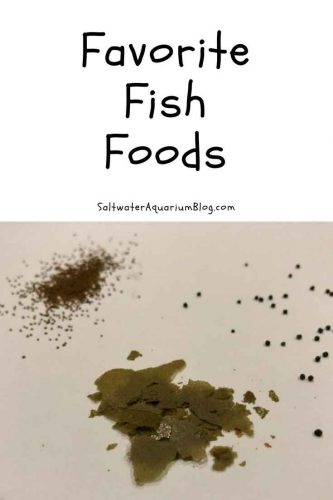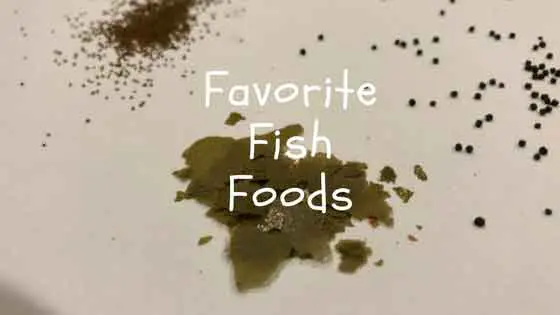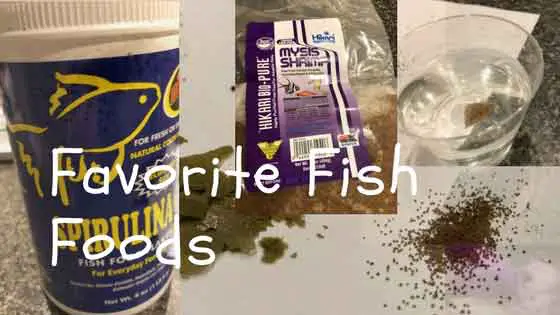This may sound obvious, once you read this, but feeding the animals in your tank is one of the most important things you will do for them. Surprisingly, however, people don’t talk much about food in this hobby, and I don’t see a lot written about the topic. Since I love awkward conversations, I thought, this would be great to write about my favorite saltwater fish foods.
On the reef, your fish essentially enjoy the equivalent of UBER EATS delivery, each and every day. The currents wash the food right up to the omnivores. The herbivorous tangs graze on the rocks and the predators hunt abundant food.
In your saltwater tank system, however, your fish eat what you feed them—so it’s important to feed them the right amounts of high-quality foods.
Feeding your fishes too much food at a time creates waste, spikes in nutrient levels and problem algae growth. It’s probably one of the most significant ways we negatively impact our own tank water quality.
But that’s because feeding them too little, on the other hand, causes them to be malnourished, and in the worst instances, starve.
We’re all nice people, we love our reef fishes and animals, we want to feed the right amount of the right foods, but how much is just enough?
How much should you feed your saltwater fish?
How much should you feed your saltwater fish? Well, that depends. If our goal of reefkeeping is to recreate that slice of nature as best we can, then perhaps the best compass is to look at their natural behaviors:
- Predatory fish, like lionfish, tend to eat big meals, occasionally. They catch what they eat, and they don’t spend all their time catching. So their meals tend to be episodic. So it makes some sense to try and replicate that, as best you can.
- Grazing herbivorous fishes, like tangs, butterflies, and angelfishes, seem to eat all the time on the reef. The good news is that a mature tank will have some natural film algae they can eat, as well as the food you feed them, so the goal should be to allow for grazing of some sort throughout the day
- Omnivorous fishes, like the royal gramma, seem to eat whenever there is food to be eaten.
Reader be warned here– (sorry, I mean you!) I’m about to make a big fat generalization. The problem with generalizations is that they’re generally wrong, but in my personal experience and research (meaning what I’ve read about what other people do successfully) is that except for the big predators, most of the fishes we tend to keep in our tanks would do best with small feedings several times a day.

If only we could prioritize feeding our fishes above everything else we have to do in our days. The limiting factor, in my life, is my own schedule, and as a result, I tend to feed my fishes just once per day, at night. But that’s a tradeoff I make based on my own work-life imbalance.
If I was home, or if my tank was at work, I’d try to give my fishes 3-4 square, smaller meals a day.
My breeding fish pairs tended to spawn more regularly when they were fed more often.
So my advice to you is to do the best you can. If that’s one time a day—make it work. If you can do two, (for example, before and after work), that’s great. If you can do more, do more. Just make sure you scale back the quantity and make sure you target feed, as necessary, meaning you take the time to ensure food gets to even the shy animals in your tank.
Of course, I strongly encourage you to look for feeding information specific to the species you’re interested in keeping first and always trust that (there’s another generalization) above general information like this.
Will my fish starve while I’m on vacation?
One common question I get is, will my fish starve while I’m on vacation? Or do I need to have a fish-sitter come feed my fish every day while I’m gone?
The short answer is that otherwise happy, healthy fish in a mature tank will probably not starve while you go on vacation, assuming your vacation is for a week or less, with a bunch of caveats and extra considerations.
Ideal scenario
The ideal scenario for the animals in your tank would be zero disruption. If you could program your Alexa-device to feed your fish while you’re gone or have a fish-sitter stopover, that, of course, is ideal. Although you also run the risk that the sitter accidentally feeds your fish too much, which is the opposite problem.
But I’m a practical person, and it’s not always practical to have someone feed your fish while you’re gone.
A good scenario
Asking a friend or neighbor to check in on the tank once every few days is a pretty good scenario. Remember, if you have a mature, healthy reef tank, chances are, there is food in the tank already, in terms of film algae, copepods, etc., (hopefully). And if not, remember, it’s probably not much worse than having a bad day at the reef where your fish was being chased by a hungrier fish that day and didn’t eat because it was fleeing a predator.
An okay scenario
It won’t be the end of the world, or your reef tank if you skip feeding your fish for a few days, or even a week, in some/most cases. I encourage you to use your judgment here, based on how much experience you have with your tank and with leaving it for a day or two.
Please don’t be confused either, I’m not saying this is a best practice. I’m sure your fish would appreciate being fed while you’re gone, but healthy fish can survive a fast of a few days.
I’ve experimented with this and been okay. If this is your only or best option, it’s probably going to be okay. What I have done, in the past, is beef up my feedings before I go, to give them a bit of a calorie cushion to start off.
Sometimes, you can’t get a fish-sitter.
The big disclaimer here is to make sure you think about the fish in your tanks. I’ve never kept anthias going, a notoriously calorie-crunching fish. If I was keeping more sensitive fishes, I would plan to make other arrangements
Automated feeding
If you’re planning to be away from your tank for a few days, an automatic fish feeder might seem like a good option. It is very literally a technological solution for a true pain point for those of us with saltwater aquariums.
However, I encourage you to use caution if you’re exploring this option. I’ve heard some horror stories from readers of this blog (and read other accounts online) where the machines either jammed up due to moisture or dumped in a bunch more food than they were expected to.
I’m not saying it’s definitely machine-error–it might human error, but the solution to the fish-sitter problem may cause an entirely worse problem than not feeding your fish at all.
Even the highest-rated automatic fish feeder on Amazon has about 17% of the reviews at 3 stars or below. You can check out the reviews here if you want.
Please use caution if considering an auto-feeder and especially be cautious about setting one up right before you leave town. I wouldn’t advise using any new equipment of any sort before you go.
Also, consider the DIY auto-feeder route. I’ve seen some pretty cool threads about people who have figured out how to thaw and feed frozen foods over time. If you could build it for daily use and be comfortable that it works flawlessly, that, to me, is the ultimate solution. But it’s not necessarily the easiest solution.
What are my favorite saltwater fish foods?
Are you curious about what I feed my saltwater fish? I try to mix it up a bit. Here are the saltwater fish foods that I have depended on the most, over the years.
Live foods
For helping fish get ready to spawn, my two favorite live foods are live black worms and live brine shrimp. I’m fortunate to live in an area with a few good local fish stores in the area so I can get brine shrimp from one and black worms from another.
Blackworms are loaded with calories. Feed them sparingly, because they don’t last long in saltwater. Rinse them thoroughly, because they can bring in harmful bacteria, but most of my fish eat them greedily—and I’m a big believer that they’ve helped me fatten up my clownfish and cardinal fish before breeding.
Live brine shrimp (Artemia) are great, too. It is best if you catch this live saltwater fish food in a net and rinse them with tank water prior to adding them to your tank because their water is often polluted and full of ammonia (that you don’t want to add to your tank), but there is something about the rhythmic pulsing of their swimming and irresistible size that makes fish go nuts chasing and eating them.
When I first started out, I’d buy a bag and add the whole contents to the tank (fouling the water in the process…not good). I’d watch, and my fish would gorge themselves to the point that they looked like they wanted to burst. Luckily, they never did (burst, that is)…
Frozen foods
My favorite frozen food is mysis shrimp.
I’ve fed my fish with frozen brine shrimp, bloodworms, omnivore diet, plankton diet, angelfish diet, but no frozen food has ever been eaten as greedily or universally as mysis shrimp. Everyone gets in on the party when there are mysids to eat.
In terms of what I buy—I buy the cubes and the sheets at different times, for different reasons. The sheets are certainly an economical play. You get a lot more food for the money when you buy the sheets.
But what you lose in that transaction is convenience. And busting up those sheets can be fairly inconvenient. I know this is a first-world problem, but what can I say? I get bored/frustrated with breaking up that sheet after a while.
So I use sheets for a time until I get sick of them. Jump back to the cubes until I get sick of paying then flip back.
Do you do that too? or are you loyal to one format over the other?
Dry saltwater fish foods
Pellets
I don’t feed pellets all that often. While I had my fish room going in my basement, I used to feed Hikari brand micro pellets a lot—because I didn’t have crazy water flow going on (they were breeder tanks, not reef tanks), and the clownfish were basically trained to come up to the front and eat (so waste wasn’t an issue). Those are not a saltwater formulation. I know.
Now that I have my nano going in my office here behind me, I do find that the pellets are a bit easier to feed.
I used the Ocean Nutrition pellets for a while to feed my clowns and goby in my rimless aquarium (the nano in my office) and they were recommended to me by Jason Oneppo from ON. They were fine.
But in general, I like, don’t love pellets, and let me tell you why. I like that they are nutrient-dense. In terms of efficiency, they are a good food. Each pellet packs a nutritional punch.
However, what I don’t like about pellets is that they’re a hit-or-miss food. Your fish is either paying attention, the millisecond it rips through the water, or it is not—and if it is not, you have pellets lying around on the floor. So now you either bought yourself a little extra cleanup time—or you pollute your water–and that’s where the nutrient-density of the food works against you–it creates more waste.
So I’m still on the fence about pellets.
I know clownfish breeders tend to swear by them, so I’m curious if I’m ‘doing it wrong’. Do you love pellets more than I do?
Flakes
Flake foods are the ultimate in convenience. When I first started in the hobby, I was afraid (or maybe the right emotion is embarrassed) to try flake foods.
Flake foods (tetra brand, all day, every day) was what I fed my freshwater fish before I had a saltwater tank, and before I had large-mouthed, always hungry cichlids. In fact, I can still remember the smell of opening up a fresh container of Tetra brand flakes.

It wasn’t until I matured a bit in my hobby and was asked to try flakes again by a blog sponsor who had a flake food line, that I realized and became comfortable feeding them to my fish too. Even as I write this, I wonder…are you going to judge me…because I don’t thaw all my meals?
What I love about flake foods is that they require zero prep, zero handling. They’re always there and they seem to last forever. Yes, they do technically get stale, but…I’m not sure I’ve ever noticed my saltwater fish caring about it.
On a busy night, I just grab a pinch and swirl it into the water—and my fish love them. They eat the SPIRULINA flakes greedily.
I’ve tried other flake foods.
Ocean Nutrition flakes are fine. Omega one flakes are fine. Other Zoomed brands are okay (they didn’t like the earthworm flavor), but one of my saltwater fish food favorites, because of the price, convenience and relative zest with which my fish consume it—is the SPIRULINA flakes from ZooMed.
None of these were scientific comparisons, just lazy, loosely-held observations
In full disclosure, I tried SPIRULINA flakes first, because ZOOMED was an advertiser on this website, and while they didn’t pay me to try the food specifically, they did send me a box of things to try, including the flakes.
But I can honestly, and in good conscience let you know that I’ve been a voluntary, paying customer, ever since, and I can also say that I much prefer those flakes to any of the other flakes in their line. I’m convinced my fish like them more.
Freeze-dried saltwater fish foods
There was a period of time, a few years ago, where I used a lot of freeze-dried foods–not for my reef tank, but in my basement when I was breeding fish. At that time, I was feeding my fishes a lot, and also doing a lot of maintenance tasks (growing phytoplankton strains, growing rotifers & pods, growing fish babies, cleaning tanks, etc.) and freeze-dried foods seemed like more of a whole food than flakes or pellets but weren’t as inconvenient as frozen or live foods.
So I used a fair amount of freeze-dried mysis from San Francisco Bay

Then, one day, I just sort of stopped, abruptly. I don’t think there’s a good story there, I think it was just a Forrest Gump moment.
Because they just sort of float, I don’t find the freeze-dried foods to be as convenient in a reef tank.
Do you like any foods like this for your tank?
Seaweed
Over the years, I’ve also added a lot of seaweed sheets to my tank. Ocean Nutrition, Julian Sprung’s sea veggies, and, of course, I’ve purchased the Nori sushi roll seaweed sheets, as well.
I can’t say that I’ve noticed much of a difference between brands or even the human-food version. It’s okay food. I know it’s important for tangs, butterflies, and angels. I can’t say I get excited about it.
What is my overall saltwater fish food favorite?
Here’s a scenario that I just KNOW you’re thinking about all the time. What saltwater fish food would you want with you, if you were stuck on a desert island with your aquarium?
If I was on a desert island with my saltwater aquarium and could only take along two fish foods with me, I’d take along my overall saltwater fish food favorites:
- Frozen Mysis shrimp cubes
- Spirulina Flakes
Of course, I know there are complications here—how do I keep the MYSIS frozen, if I’m on a desert island—how did my fish tank get there, unbroken and how am I running it—you’ll have to wait for the story prequel to come out to get all that background.
Okay, it’s just silly. I know.

Here’s my intended conclusion. Around my house, I tend to have both frozen mysid and spirulina flakes around the house. When I’m upbeat, energetic and enthused about my tank, I thaw out a cube.
When I’m running a taxi-cab service driving kids around, sick, tired, over-worked or lazy, or if it’s a day of the week that ends in Y, I feed the flakes.
Flakes are an everyday staple for me, as I get older and lazier, and feeding MYSIS makes me feel like a good aquarium owner—kind of like how dog and cat owners feel when they feed canned food, I suspect.
Well, that’s my story. Thanks for making it through to the end. How about you, what’s your saltwater fish food favorite? Anything you recommend that I should try?






Leave a Reply